Blooper 20: The Circle Game: Active Link to Here
| < Day Day Up > |
Blooper 20: The Circle Game: Active Link to Here
We can't return; we can only look behind from where we came
And go 'round and 'round and 'round in the circle game (Joni Mitchell, "The Circle Game")
An extremely common navigation blooper is for a Web page to include an active link to itself. Clicking on such a link merely reloads the page. At best, this wastes people's time as the page reloads . At worst, it can be very disorienting, because users may not recognize the redisplayed page as the same one they were on. How can they not notice that? Consider the following situations:
-
The user clicks a self-link while scrolled down the page, but it redisplays at the top. The user may never have even seen the top of the page due to arriving from elsewhere via a direct link to an anchor point far down the page.
-
The page has images that change each time it is displayed.
-
The page contains animations, applets, or other dynamic content that takes so long to start up that the user temporarily can't see what page this is.
In addition to these problems, disguised self-links can cause unintended loss of data, because any data that had been entered into forms on the page will be lost.
This blooper has several variations, depending on where the active self-links are positioned on the page.
Self-links in Navigation Bar
The most common form of this blooper is for all the links in a site's ever-present navigation bar to be active on all pages. Examples can be seen at ComputerWorld.com, an online computer magazine, and MSDN.Microsoft.com, the Microsoft Developers' Network website (Figure 3.35).
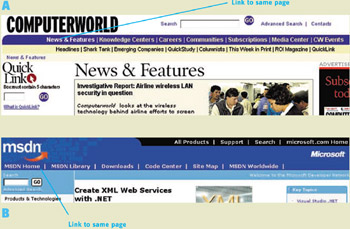
Figure 3.35: Navigation bar has active link to this page- A- ComputerWorld.com (Jan. 2002); B- MSDN.Microsoft.com (Feb. 2002). No useful purpose and potentially disorienting.
The main cause of this form of the blooper is that the HTML code for the navigation bar is often simply copied onto every page of the site. Every navigation bar link is therefore active on every page. It takes more work to alter the code for each page so a page's own navigation bar item is not active.
How harmful is this? It depends on how clear it is to site users that the link is a self-link. If the current page is strongly identified, either at the top of the page content or on the navigation bar itself, users probably realize that the link is a self-link. If the current page is not clearly identified, users may well not realize that the link is a self-link and click it.
For example, health and safety organization NSF International's home page could easily be mistaken for a splash page (Figure 3.36). It doesn't indicate that this is the home page, so visitors might think the home page is a different page and click Home to get there.
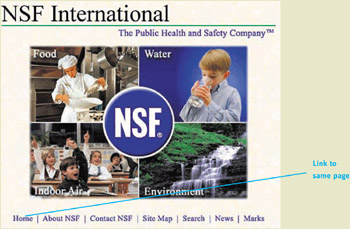
Figure 3.36: www.NSF.org (Sept. 2002)-Active link to home on home, which could be mistaken for separate splash page.
Which Home Page?
A related form of linking to the current page concerns large websites segmented into several subsites, each with its own home page. Often, such sites provide an auxiliary navigation bar to allow users to navigate between subsites in addition to the normal navigation within the current subsite . In such sites, if the home page link is active on its own home page, it is a blooper. Enron.com provides an example (Figure 3.37).

Figure 3.37: www.Enron.com (Mar. 2002)-Wholesale Services home page has active link to this page as well as to Enron.com home.
Self-Links Not in Navigation Bar
Self-links that are not in the navigation bar tend to be more trouble than those that are in the navigation bar. Site users often can't easily tell whether such links come back to this page or not. Users who click on such a link may not initially realize that the same page has been redisplayed, especially if they were scrolled down the page or the content changes with time. As we shall see, that's only one of several potential problems.
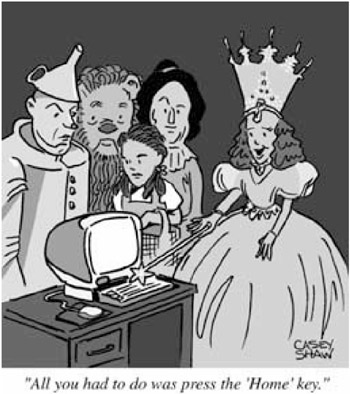
Copyright 2002 Casey Shaw/USA Weekend magazine used with permission
At iFilm.com, the tab that labels the film-credits page as the "Credits" page is also a link to ... the Credits page (Figure 3.38). It is not apparent that the link is to this page.
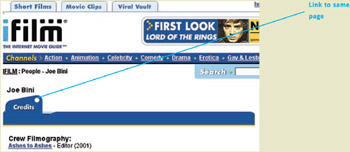
Figure 3.38: www.iFilm.com (Jan. 2002)-Tab identifying this page as the "Credits" page is also a link to the "Credits" page, that is, here.
Amazon.com provides an excellent example of how non-navigation bar self-links can disorient users. In the Help section of the site is a Contact Us page for emailing questions to the company. At the bottom of the page is this instruction: "Still have questions? Search help or contact us" (Figure 3.39). The "contact us" link goes to the Help>Contact Us page, which is this page. Some customers may go around this loop a few times before realizing they aren't going to get their questions answered .
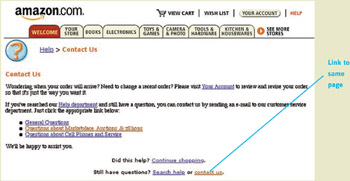
Figure 3.39: www.Amazon.com (Feb. 2002)-"Contact Us" link at the bottom of page returns to this page.
When self-links on web pages are combined with poorly managed frames , the results can be downright hilarious. RCN.com, a site providing position papers on technology policy, employs a common two-frame design for displaying papers: a table of contents in one frame and the paper content in the other frame (Figure 3.40[A]). The first page of some papers includes a link to the paper. Clicking on those links displays the paper-table of contents and page content-in the right frame (Figure 3.40[B]). If users don't realize what is happening (e.g., because they didn't realize that the link was a self-link), they can get into an infinite sequence, with the paper displayed in ever-shrinking frames (Figure 3.40[c] and [d]).
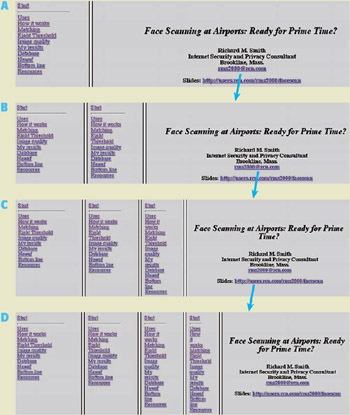
Figure 3.40: www.RCN.com (Nov. 2001)- A- Papers shown in two frames- table of contents in left frame, document content in right frame. B- Clicking on a document link in the right frame redisplays the document in the right frame, splitting the right frame into two frames. ( c, d ) Continuing to click on a document link in the rightmost frame causes an infinite sequence.
Self-links sometimes appear both in the navigation bar and elsewhere on a page; we saw this at Monterey.com's Help page (see Figure 3.19). In such cases, the likelihood for user confusion about which links are self-links and which are not is very high.
Avoiding the Blooper
Nielsen and Tahir (2001, p. 19) give the following design rule:
Don't include an active link to the homepage on the homepage.
This rule can be generalized to any page:
Don't include an active link to the current page.
Some Web developers "justify" active navigation bar links to the current page by arguing that Web users occasionally need a way to refresh the page. Sorry, that's a poor excuse . Most browsers have a "Reload" button, allowing users to refresh the page in the rare cases when they must. The main reason this blooper is so common is that it's easier to use the exact same navigation bar code on every page than it is to alter the code for each page.
But hey, it's not that much more work, after copying the navigation bar code, to edit out the link to the current page. The Search site Google.com does this (Figure 3.41).
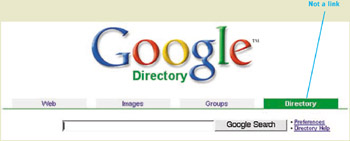
Figure 3.41: www.Google.com (Sept. 2002)-Navigation bar item for current page ( marked ) is not a link.
| < Day Day Up > |
EAN: 2147483647
Pages: 128